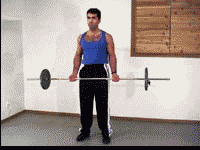The Crucial Part
 The mind-muscle connection is as much a crucial part of maximizing gains as anything else. The problem lies when people are focusing more on just getting the weight to move than they are on getting the correct muscles to do the work. The first key to doing this is to understand what each muscle is actually intended to do. When you ask a person what the pectoral muscle does, you generally get "it's for the bench" and quads are "for squatting."
The mind-muscle connection is as much a crucial part of maximizing gains as anything else. The problem lies when people are focusing more on just getting the weight to move than they are on getting the correct muscles to do the work. The first key to doing this is to understand what each muscle is actually intended to do. When you ask a person what the pectoral muscle does, you generally get "it's for the bench" and quads are "for squatting."
I'll use the example of biceps, being the classic muscle to work out. Try this as you're reading, simply contract your biceps. What do you have to do? You have to curl your arm. Now obviously the only way to make the muscle grow is to make getting into that position as difficult as possible. Examining the barbell curl in this sense:
Practice Form
When the average person takes a barbell into their hands, they think of one thing: getting that barbell to the top under any circumstances. Now the next time you get into the gym and are working your arms don't put any plates on that bar at first. Simply pick up the bar and again contract your arms as hard as you possibly can. Take a moment to look at where your arms are. Your upper arms should be hanging straight down, your elbows are at your sides, and your forearms are up as high as they can without being vertical.
This is exactly where you want to be at the top of a barbell curl. If your elbows are forward, your upper arms not straight down, and your forearms are vertical, you will find that your biceps have relaxed. This is obviously counterproductive. Now lower the bar slowly as far as you can without straightening your arms out. You will again notice that your biceps are tense for the entire movement, and this is exactly how a barbell curl should happen.
Contracting The Muscle
 The key point here is that the focus, rather than being on moving the weight, should be on contracting the muscle. Your muscles have no idea how much weight is being moved, or how the weight is being moved. They can only do one thing, and that is pulling their designated limb into their designated position. In the case of the barbell curl, the only thing the biceps do is pull the forearm toward the upper arm.
The key point here is that the focus, rather than being on moving the weight, should be on contracting the muscle. Your muscles have no idea how much weight is being moved, or how the weight is being moved. They can only do one thing, and that is pulling their designated limb into their designated position. In the case of the barbell curl, the only thing the biceps do is pull the forearm toward the upper arm.
If, during a curl, your body is doing anything extra, then the biceps are not working. It's as simple as that.
A muscle can only pull, realize this. A muscle cannot push. When a muscle contracts, it shortens, pulling the attached limb along with it. A squat is a combination of a few muscles working synergistically: The quads work to pull your lower leg straight with the upper leg; the calves push your lower legs to parallel with the ground; the glutes and hamstrings work together to pull the entire leg straight with the upper body. This is the action of a squat. When you squat, you must realize what muscles are pushing from where and work to think the muscle into a contracted position, rather than just focusing on the weight on your back.
Resistance
Again I must emphasize that your muscles only feel resistance. If your arm is only capable of curling 75 pounds, 115 pounds can only be given 75 pounds of resistance at the most from your biceps, the only difference being that along the way you put your back at risk from cheating. Piling on extra weight and hurling it around with your hips isn't adding resistance to your biceps, more weight can't magically add to the capabilities of your muscles, it only means that in order for you to move the weight, you must transfer the workload to other muscles, which defeats the purpose of any lift.
I hope the next time you get into the gym, you think of your lifts in this manner. Just remember that going heavy is the name of the game, but under no circumstances should that mean you go heavier than the target muscle is capable of moving on its own.
Until next time,
